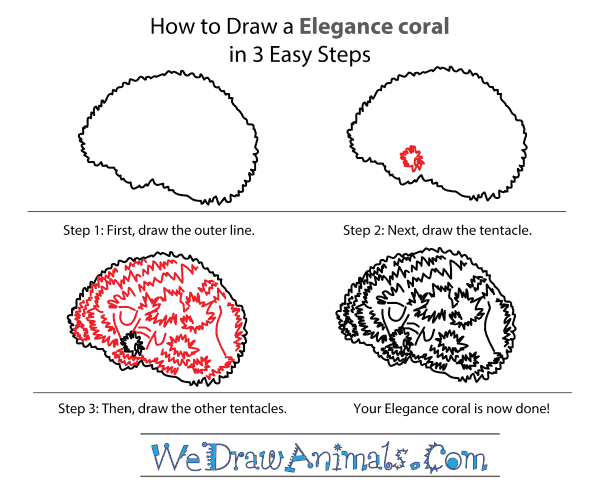In this quick tutorial you'll learn how to draw an Elegance Coral in 3 easy steps - great for kids and novice artists.
The images above represent how your finished drawing is going to look and the steps involved.
Below are the individual steps - you can click on each one for a High Resolution printable PDF version.
At the bottom you can read some interesting facts about the Elegance Coral.
Make sure you also check out any of the hundreds of drawing tutorials grouped by category.
How to Draw an Elegance Coral - Step-by-Step Tutorial
Step 1: First, draw the outer body of the coral. It's roughly ovular, with little bumbs to make it look more realistic.
Step 2: Now you'll draw the first tentacle. It's essentially a messy circle, with bumbs and squiggles.
Step 3: Now, it's pretty simple from here. Keep drawing tentacles until the body is full.
Interesting Facts about the Elegance Coral
Elegance coral (Catalaphyllia jardinei) is a coral found in the Pacific Ocean, known for its beautiful colors. The coral, or skeleton of the animal, is stony looking, and has colorful trunks that grow from it called polyps.
Did you know?
- Elegance coral is also referred to as ridge coral, elegant coral and wonder coral.
- The coral’s polyps extend during the day, showing off its green, blue, orange, and purple tips.
- Elegance coral can reproduce sexually like many coral, but they are also able to produce asexually by sprouting new branches.
- This coral features a large, disc-like mouth, and the polyps can draw bits of food, like small shrimp, into it. Like many coral, they are also home to small organisms that convert sunlight to food for the coral.
- Elegance coral prefers to grow in soft sand rather than on harder surfaces like rocks.
- Due to its unique beauty, elegance coral is highly sought after for personal aquariums.
Lesson plan note: Although they have a symbiotic relationship with organisms that help feed them, elegance coral evolved to also have a mouth to gather food. Discuss why this evolution may have happened.




